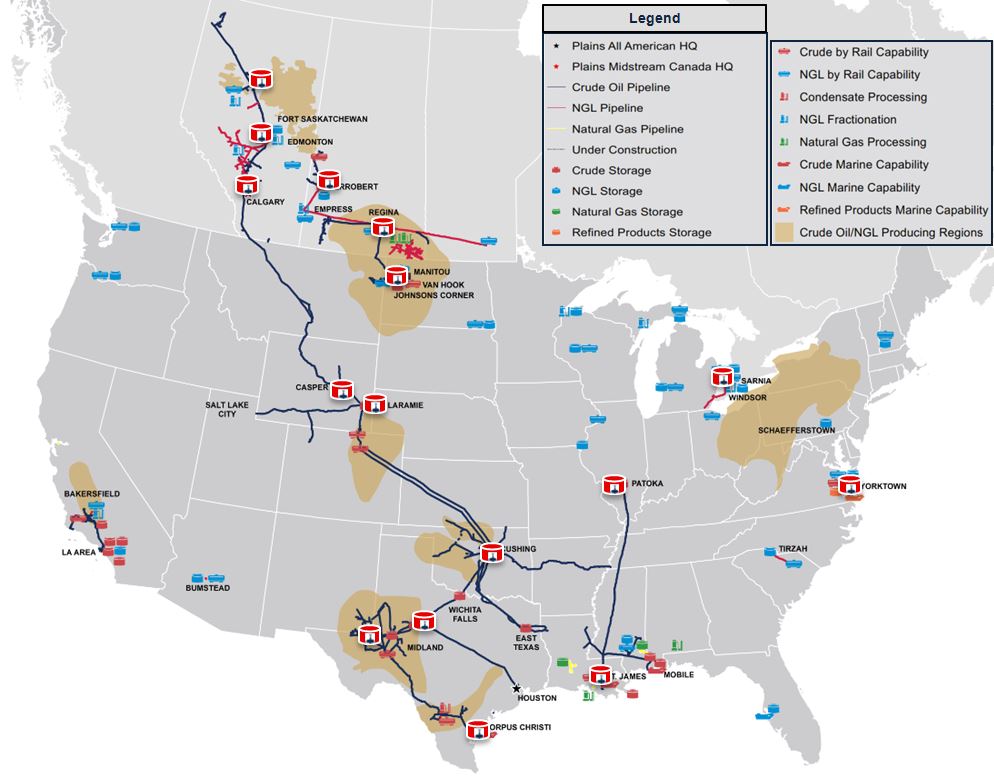Shout out to Cohort 5 from Houston, Texas!
It has been quite a busy past few months here working for Plains All American Pipeline, LP. A quick description of our company… Plains All American (PAA) is a publicly traded company that owns and operates midstream energy infrastructure and provides logistics for crude oil, natural gas liquids, natural gas, and refined products. We own an extensive network of pipeline transportation, terminalling, storage and gathering assets in key crude oil and NGL producing basins in both the United States and Canada. Long story short, we are in the business of transporting crude oil and natural gas derivatives across the United States (image below). We do not participate in the processes of oil exploration and extraction (with the exception of a few natural gas extracting activities.)
Now… What am I, as a student of the MSEM program, doing at a midstream oil company? First, I’ll talk about what I have been doing for the company outside of my personal project. And second, I will give a brief overview of what I have been tasked with completing as a personal project for St. Ed’s.
On the day to day basis, I am working with the Environmental and Regulatory Compliance group of PAA. As an intern, I have been assisting with the permitting required to install a pipeline, the remediation team in charge of remediating impacts from the installation of pipelines, and the Operational Management Systems team. By working with these various groups, I have been able to gain firsthand knowledge of what it is like to participate in environmental management. It is incredible to see how a proposal for a pipeline drawn on a map, can transform into a lengthy process of gathering permits, issuing work orders, and coordinating consulting and survey groups (image below). After all the proper requirements are met, the pipeline construction can begin. Once the construction has been completed under the purview of engineers, and various federal and state representatives, the land is remediated to the fullest extent possible back to conditions before construction. If you know where to look, time lapse images from the construction of the pipeline, to the successful remediation of impacted areas, is quite amazing, as many times, no difference can even be distinguished after 5-10 years. Successful examples of how energy is provided to millions of homes across the United States through pipelines that many landowners do not even know exist.

On to my personal project… I have been tasked with researching sustainability, determining what it could mean for the company, and ultimately creating a sustainability report. As I only have about 3 and a half months to complete my project, I decided to focus solely on the “pure-play” aspects of midstream energy as it relates to crude oil. After researching various sustainability standards such as the GRI, ISO, CDP, Sustainalytics, FASB, and CDSB, I decided to follow the SASB.
The SASB Sustainability Accounting Standard (SASB Standard) was established to maintain sustainability accounting standards that help public corporations disclose material (impacts), and decision-useful information to shareholders in SEC filings. These Standards are designed to help companies comply with existing regulatory obligations while working within the framework of existing US securities law. The SASB Standards are intended to complement financial accounting standards, such that financial and sustainability information can be evaluated side by side to provide a complete view of corporate performance and prospects. Through this standard, I have been in the process of gathering greenhouse gas & other air emissions inventories, ecological impact assessments, competitive behavior insights, and operational safety, emergency preparedness, and response activities. This has been quite the task as the company has over 19,200 miles of pipeline, 31 million barrels of active, above-ground storage tanks, 60 transport barges, over 820 trucks, 1065 trailers, and 10,600 rail cars.
Through this internship, I have been able to gain firsthand knowledge on what it means to have a Master’s in Environmental Management and Sustainability in an industry that provides crucial energy infrastructure nationwide. With my degree, I am hoping to make fundamental and lasting impacts on Plains All American in a changing world where the environment comes first.

Looking forward to seeing everyone in May!
Nicolas Gonzalez